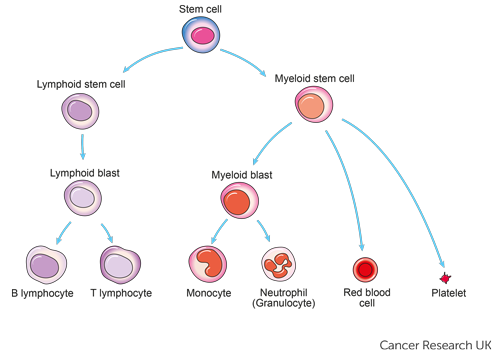Chronic Myelogenous Leukemia is a slowly progressing blood and bone marrow disease that usually occurs during or after middle age, and rarely occurs in children.
Chronic Myelogenous Leukemia ICD 10 is C92.1.
Tap “Watch Now” for an easy-to-understand overview of Chronic Myelogenous Leukemia.
- Chronic Myelogenous Leukemia
Overview
Chronic Myelogenous Leukemia (CML) is a slowly progressing blood and bone marrow disease that usually occurs during or after middle age, and rarely occurs in children. In CML, too many blood stem cells become a type of white blood cell called Granulocytes shown here in orange . These Granulocytes are abnormal and do not become healthy white blood cells.
In Chronic Myelogenous Leukemia (CML), the disease is classified by phase: chronic phase, accelerated phase, or blastic phase. It is important to know your phase in order to make a treatment plan with your doctor.
What Tests Will I Need and Why?
Blood and Imaging tests are done to understand your general health and confirm your diagnosis.
TBiomarker testing is done in the blood and bone marrow to identify certain biomarkers such as Philadelphia Chromosome (Ph), which helps determine the best treatment option for you. Ph+ is found in most patients with CML.
You will also require a bone marrow biopsy and in some cases, a sample of spine liquid, to obtain more information about your diagnosis.
If your treatment team has not already performed tests to determine your cancer’s features, please ask your doctor when these tests will be performed. This information is critical to finding the best treatment option for you given your goals and lifestyle needs.
Re-read this summary as needed and then tap, “Compare My Treatment Options Now“. Our unique Comparison Page will help you understand your FDA-approved treatment options including, who can help you pay for your treatment, where and how each is given and what side-effects you may experience.

National Institute of Health/ treatment-leukemia
Recommended Leukemia Cancer Videos

What Is Blood Cancer
Brought To You By Black Health Matters

Leukemia Causes, Signs and Symptoms
What is Leukemia?

How Cancer Spreads
Metastastis

Diagnosing Your Cancer
How Does a CT Scan Work?

Diagnosing Your Cancer
How Does a PET Scan Work?

Exercise! You Can Do It
Reducing Side Effects & More
Commonly Searched Questions
Chronic Myelogenous Leukemia (CML) Definition
Chronic myelogenous Leukemia (also called CML or chronic granulocytic Leukemia) is a slowly progressing blood and bone marrow disease that usually occurs during or after middle age, and rarely occurs in children.
Source: www.cancer.gov
Chronic Myelogenous Leukemia (CML) Survival Rate
The average five-year survival in Chronic Myelogenous Leukemia (ALL) is 70.4%.
According to SEER data, Chronic Myelogenous Leukemia has a survival rate of 70.4%. For example, if the 5-year relative survival rate for a specific stage of chronic myelogenous leukemia is 70.4%, it means that patients who have that cancer are, on average, about 70.4% as likely as patients who don’t have that cancer to live for at least 5 years after being diagnosed.
Source: www.cancer.org
Chronic Myelogenous Leukemia (CML) Symptoms
Signs and symptoms of chronic myelogenous leukemia include:
- feeling very tired
- weight loss for no known reason
- drenching night sweats
- fever
- pain or a feeling of fullness below the ribs on the left side
Source: www.cancer.gov
Chronic Myelogenous Leukemia (CML) Treatment
There are no specific prevention strategies for Chronic Myelogenous Leukemia (CML) due to the complexity of its causes, which involve genetic mutations and environmental factors. However, general strategies to potentially reduce cancer risk include:
- Avoid Exposure to Radiation: Minimize unnecessary exposure to high levels of radiation, including certain medical treatments and environmental sources.
- Limit Exposure to Harmful Chemicals: Reduce exposure to known carcinogens, such as certain industrial chemicals and pesticides.
- Healthy Diet: Eat a balanced diet rich in fruits, vegetables, and whole grains.
- Regular Exercise: Engage in regular physical activity.
- Avoid Smoking: Do not smoke, as tobacco use is linked to various cancers.
- Manage Existing Health Conditions: Effectively manage any chronic health conditions that could contribute to cancer risk.
These general measures focus on reducing overall cancer risk and promoting good health. For personalized guidance and risk management, consulting with a healthcare provider is recommended.
Source: www.cancer.gov
Chronic Myelogenous Leukemia (CML) Recurrence Rate
The recurrence rate for Chronic Myelogenous Leukemia (CML) is generally lower compared to other leukemias, thanks to advances in treatment, particularly with tyrosine kinase inhibitors (TKIs) like imatinib.
Key Points on CML Recurrence Rate:
- Chronic Phase: For patients in the chronic phase of CML, the treatment response is typically very positive. With the use of TKIs, the majority of patients achieve a complete cytogenetic response, meaning no detectable CML cells are found in the blood or bone marrow. Long-term remission is common, with relapse rates being relatively low.
- Advanced Phases: If CML progresses to the accelerated phase or blast crisis, the risk of recurrence and progression is higher. Patients in these stages have a more challenging prognosis and may require more intensive treatment.
Overall, with modern treatment options, many patients with CML can achieve long-term remission and manage the disease effectively. Regular monitoring and adherence to therapy are critical in maintaining remission and addressing any signs of recurrence promptly. For the most accurate and personalized information, it’s best to consult with a healthcare professional.
Source: www.cancer.gov
Chronic Myelogenous Leukemia (CML) Prevention
There are no specific prevention strategies for Chronic Myelogenous Leukemia (CML) due to the complexity of its causes, which involve genetic mutations and environmental factors. However, general strategies to potentially reduce cancer risk include:
- Avoid Exposure to Radiation: Minimize unnecessary exposure to high levels of radiation, including certain medical treatments and environmental sources.
- Limit Exposure to Harmful Chemicals: Reduce exposure to known carcinogens, such as certain industrial chemicals and pesticides.
- Healthy Diet: Eat a balanced diet rich in fruits, vegetables, and whole grains.
- Regular Exercise: Engage in regular physical activity.
- Avoid Smoking: Do not smoke, as tobacco use is linked to various cancers.
- Manage Existing Health Conditions: Effectively manage any chronic health conditions that could contribute to cancer risk.
These general measures focus on reducing overall cancer risk and promoting good health. For personalized guidance and risk management, consulting with a healthcare provider is recommended.
Source: www.cancer.gov






